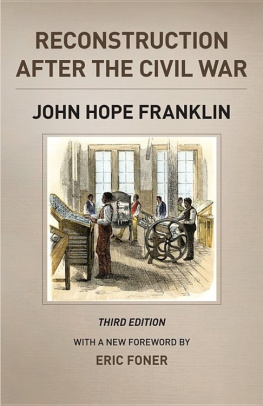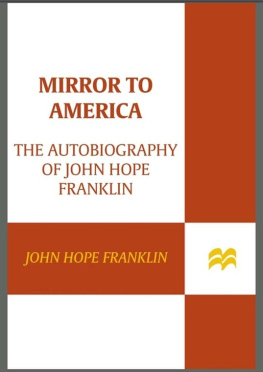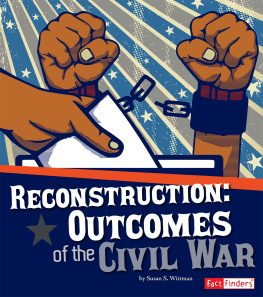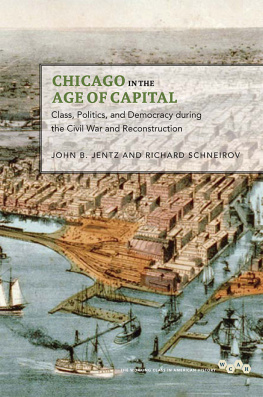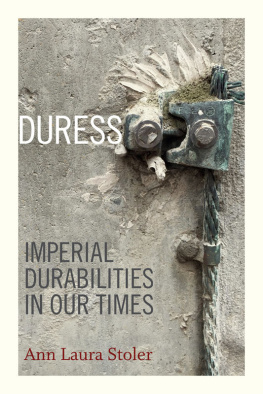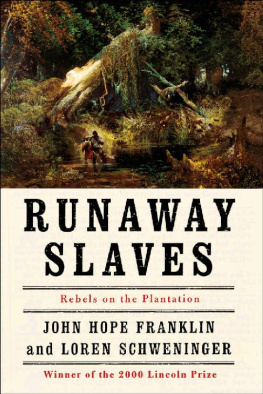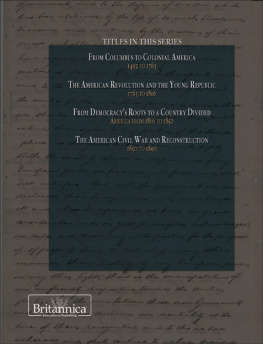John Hope Franklin - Reconstruction After the Civil War
Here you can read online John Hope Franklin - Reconstruction After the Civil War full text of the book (entire story) in english for free. Download pdf and epub, get meaning, cover and reviews about this ebook. year: 2012, genre: Politics. Description of the work, (preface) as well as reviews are available. Best literature library LitArk.com created for fans of good reading and offers a wide selection of genres:
Romance novel
Science fiction
Adventure
Detective
Science
History
Home and family
Prose
Art
Politics
Computer
Non-fiction
Religion
Business
Children
Humor
Choose a favorite category and find really read worthwhile books. Enjoy immersion in the world of imagination, feel the emotions of the characters or learn something new for yourself, make an fascinating discovery.
- Book:Reconstruction After the Civil War
- Author:
- Genre:
- Year:2012
- Rating:5 / 5
- Favourites:Add to favourites
- Your mark:
- 100
- 1
- 2
- 3
- 4
- 5
Reconstruction After the Civil War: summary, description and annotation
We offer to read an annotation, description, summary or preface (depends on what the author of the book "Reconstruction After the Civil War" wrote himself). If you haven't found the necessary information about the book — write in the comments, we will try to find it.
Reconstruction After the Civil War — read online for free the complete book (whole text) full work
Below is the text of the book, divided by pages. System saving the place of the last page read, allows you to conveniently read the book "Reconstruction After the Civil War" online for free, without having to search again every time where you left off. Put a bookmark, and you can go to the page where you finished reading at any time.
Font size:
Interval:
Bookmark:
JOHN HOPE FRANKLIN (19152009) was the James B. Duke Professor of History Emeritus at Duke University. He is the author of many books, including Mirror to America: The Autobiography of John Hope Franklin and Racial Inequality in America.
The University of Chicago Press, Chicago 60637
The University of Chicago Press, Ltd., London
1961, 1994, 2013 by The University of Chicago
All rights reserved. Published 2013.
Printed in the United States of America
22 21 20 19 18 17 16 15 14 13 1 2 3 4 5
ISBN-13: 978-0-226-92337-6 (paper)
ISBN-13: 978-0-226-92339-0 (e-book)
ISBN-10: 0-226-92337-1 (paper)
ISBN-10: 0-226-92339-8 (e-book)
LIBRARY OF CONGRESS CATALOGING-IN-PUBLICATION DATA
Franklin, John Hope, 19152009, author.
Reconstruction after the Civil War / John Hope Franklin ; with a new foreword by Eric Foner. Third edition.
pages cm. (Chicago history of Amerian civilization)
Includes bibliographical references and index.
ISBN-13: 978-0-226-92337-6 (paperback : alkaline paper)
ISBN-10: 0-226-92337-1 (paperback : alkaline paper)
ISBN-13: 978-0-226-92339-0 (e-book)
ISBN-10: 0-226-92339-8 (e-book) 1. Reconstruction (U.S. history, 18651877)
I. Foner, Eric. II. Title. III. Series: Chicago history of American civilization.
E668.F7 2013
973.8dc23
2012010482
 This paper meets the requirements of ANSI/NISO Z39.48-1992 (Permanence of Paper).
This paper meets the requirements of ANSI/NISO Z39.48-1992 (Permanence of Paper).
RECONSTRUCTION AFTER THE CIVIL WAR
THIRD EDITION
John Hope Franklin
WITH A NEW FOREWORD BY ERIC FONER
THE UNIVERSITY OF CHICAGO PRESS
Chicago and London
THE CHICAGO HISTORY OF AMERICAN CIVILIZATION
Daniel J. Boorstin, EDITOR
For
THEODORE S. CURRIER
Great Teacher and Friend
Contents
Illustrations
Foreword to the Third Edition
By Eric Foner
Over half a century after its publication, John Hope Franklins Reconstruction remains a brief, readable account of one of the most significant and most misunderstood eras in our nations history, and a landmark of American historical writing. To appreciate its contribution it is worth recalling the state of Reconstruction historiography in 1961, when the book appeared. (The text that follows is the revised edition, published in 1994, but Franklin made only a few minor changes for this version, primarily adding recent scholarship to the bibliography.)
For most of the twentieth century, the Dunning school, named after William A. Dunning of Columbia University, dominated historical writing and popular thinking about Reconstruction. In a nutshell, it portrayed the period after the Civil War as the lowest point in the whole saga of American democracy. According to Dunning and his disciples, President Abraham Lincoln at the end of the war hoped to bring the defeated South back into the Union in a quick and lenient manner. After his assassination his policy was continued by his successor, Andrew Johnson. Johnson was opposed and eventually thwarted by the villains of the piece, the Radical Republicans in Congress, motivated, depending on which historian one chose, by a vindictive hatred toward the South, the desire to fasten the grip of northern capitalism on the region, or simply the aim of keeping the Republican Party in power.
In the Dunning school account, Johnson established governments in the South headed by loyal whites who were willing to treat the former slaves fairly. But the Radicals overthrew Johnsons lenient plan and imposed black male suffrage on the defeated South. Since blacks, according to this view, are innately incapable of exercising the rights of political democracy, an orgy of corruption and misgovernment followed, presided over by African Americans, carpetbaggers, unscrupulous northerners who came to the South to reap the spoils of office; and scalawags, white southerners who turned their backs on their race and cooperated with blacks in this misgovernment. Eventually, patriotic groups like the Ku Klux Klan restored what was politely called home rule or, to put it more accurately, white supremacy.
This interpretation, which shaped the writings of three generations of historians and reached a broad popular audience through films like Birth of a Nation and Gone with the Wind, had an amazing longevity. For it was congruent with the racial system of the United States from 1900 until the civil rights era of the 1960s. The political lessons of the traditional view of Reconstruction were very clear. First, it was a mistake to give black people the right to vote during Reconstruction; therefore the white South was justified in depriving them of suffrage around the turn of the century. Any effort to restore political rights to African Americans would simply lead to a repeat of the horrors of Reconstruction. Second, Reconstruction was imposed upon the South by outsiders. The outcome proved that the only ones who understood southern race relations were southern whites, and they should resist northern calls for change in the regions racial system. Finally, Reconstruction was created by the Republican Party and therefore the white South should remain solidly Democratic (which it was until the late 1960s).
A few writers challenged this dominant account of Reconstruction. Early in the twentieth century John R. Lynch, an African American who had represented Mississippi in Congress during the 1870s, published The Facts of Reconstruction, a far more accurate and positive rendering of the events of that era. In the 1930s, the great black scholar and activist W. E. B. DuBois wrote Black Reconstruction in America, a fullfledged assault on the Dunning school, which viewed Reconstruction as a noble struggle for political and economic democracy. The tragedy of Reconstruction was not that it was attempted but that it failed, leaving to subsequent generations the difficult problem of racial justice in American society. But outside the historically black colleges, these works were largely ignored by the academy. (DuBoiss volume, a classic of American historical writing, was never even reviewed by the American Historical Review). Not until the 1960s, when the civil rights revolution altered historians views of race and destroyed the assumption of black incapacitythe intellectual underpinning of the Dunning schooldid a revisionist wave sweep over the field. Franklins book made an important contribution to this development.
By the time he wrote Reconstruction, Franklin was already one of the countrys leading historians, and certainly the most prominent African American historian.
His first book, The Free Negro in North Carolina, appeared in 1943, yet it remains not only the standard work on its subject, but a key reference point for those investigating the status of free African Americans before the Civil War. At the time he wrote, historians were devoting little or no attention to what was then called Negro history. Almost no scholarly work existed on antebellum free blacks. Franklin utilized a wide range of primary materials, demonstrating that mainstream historians neglect of African American history arose from a conscious decision, and could not be explained or excused by a paucity of available sources.
Franklin next published his path-breaking survey of black history, From Slavery to Freedom. This appeared in 1947 and has gone through many editions since. The book has introduced hundreds of thousands of students, as well as countless readers outside the academy, to the African American past. It ranges incredibly widely, from Africa to modern America, and from politics to culture, economics, and social life. Franklin did not mince words in describing the injustices and disabilities under which generations of black Americans have suffered. But as the title itself suggests, the book has an optimistic tone. It is a story of progress against heavy odds, not simply a condemnation of American racism.
Next pageFont size:
Interval:
Bookmark:
Similar books «Reconstruction After the Civil War»
Look at similar books to Reconstruction After the Civil War. We have selected literature similar in name and meaning in the hope of providing readers with more options to find new, interesting, not yet read works.
Discussion, reviews of the book Reconstruction After the Civil War and just readers' own opinions. Leave your comments, write what you think about the work, its meaning or the main characters. Specify what exactly you liked and what you didn't like, and why you think so.

